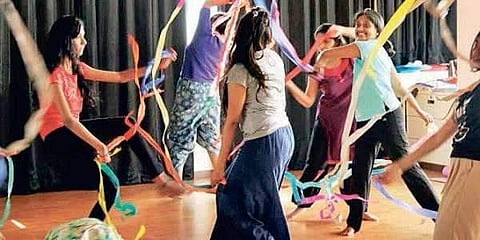

A dance movement therapist’s room is no typical consulting space. There’s no couch. It’s well-lit. And, there’s all the place for an individual, a group, or persons in wheelchairs to move freely, and express themselves through breath, movement, and dance. Even the movement of an eye helps one understand their emotions. Typically, dance movement therapy (DMT) is recommended for people who fall short of words to express feelings. World Dance Day will be celebrated on April 29, and dance movement therapists talk about dance as a medium to grow.
Tharana Katri, a dance movement therapist and founder of Horizon Therapy Centre, works mainly with children with autism. She explains that DMT is not simply ‘feel-good’ dance, or recreational therapy. It is a rigorous process, where the person in therapy moves, and the therapist helps them reflect on their movement, just like one works with language in counselling.
“Through body movement patterns, we try and understand where are the restrictions on the body while moving. For a person with anxiety, for instance, we look at how the emotion feels on their body, and work to help them open up about it,” she explains.
Children, particularly, are introduced to DMT as play. They depict themes or stories through movement, and the point is not to interpret their movement, but get information about where there are restrictions, and how one can work to build their self-esteem.
For adults, the movement also helps trigger a memory from their past. Magdalene Jeyarathnam, founder director, East-West Centre for Counselling and Training, explains that the discussion that follows every session plays an important role. “It’s a sense of empowerment when one has a breakthrough after movement. Sometimes we also ask them to write about it, or express visually through a drawing or painting, and then talk about it,” says Magdalene.
In the last few years, Chennai has become more aware of DMT and its benefits, thanks to dance movement therapists like Tripura Kashyap, Preetha Ramasubramanian, and Tharana, who regularly conduct workshops and have set up centres here. While these centres offer diploma courses in dance movement facilitation, masters courses in DMT are yet to be introduced.
Dance as a therapy, especially for children with disabilities, has been actively used by many to help improve motor and cognitive abilities. Ambika Kameshwar, founder, Rasa, a centre for theatre arts and special needs, believes that everyone responds to an innate sense of rhythm and a movement session helps us channelise it for individual development, be it a person with disability, or not. “I also would not use the word ‘therapy’ because it segregates a few into a client population who require help. At Rasa, we call it holistic development through theatre, and dance is one of the basic tools to help empower anyone,” she explains.
As Ambika suggests, one of the most common misconceptions that therapists encounter is that DMT is for a person with a problem, who requires a ‘cure’; and that there is usually a eureka moment at the end of a session. Preetha Ramasubramanian breaks it down and says, DMT is for anyone who wants to improve their emotional health and well-being. “The sessions are usually client-centred. Discussions are important because it’s when the client’s unconscious material, which they might have projected metaphorically, can be revisited,” she explains.
Sindhura B, who is training to be a therapist, shares her experience of attending DMT sessions. “We were a group of people, unsure about what would come out of the session. But we soon realised that the therapist is not a teacher who’ll tell us how to move. It was very liberating to move without feeling too conscious, and to take responsibility for it,” she says.
